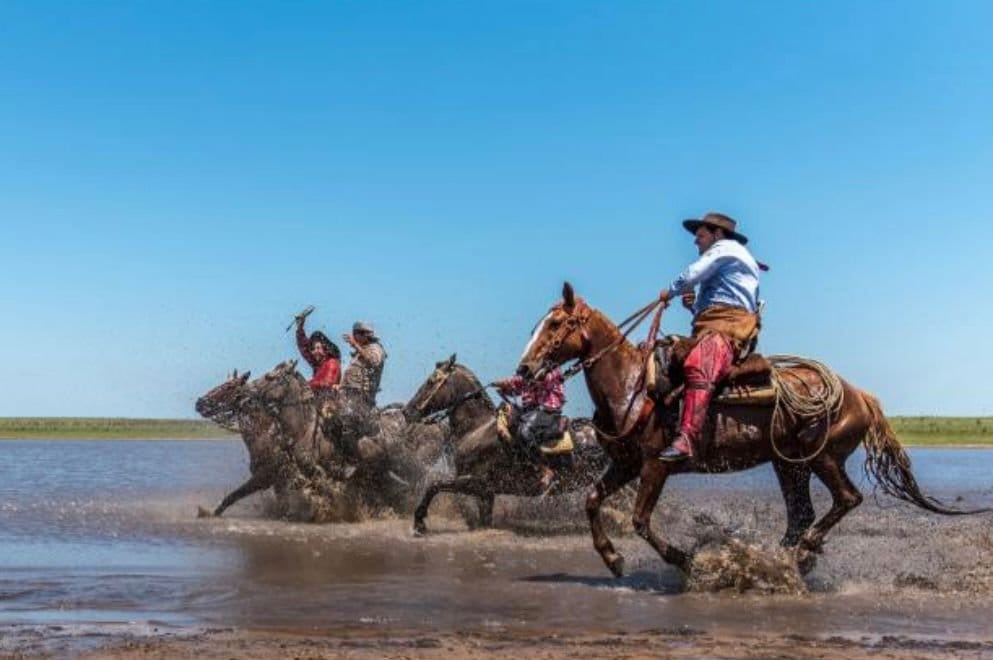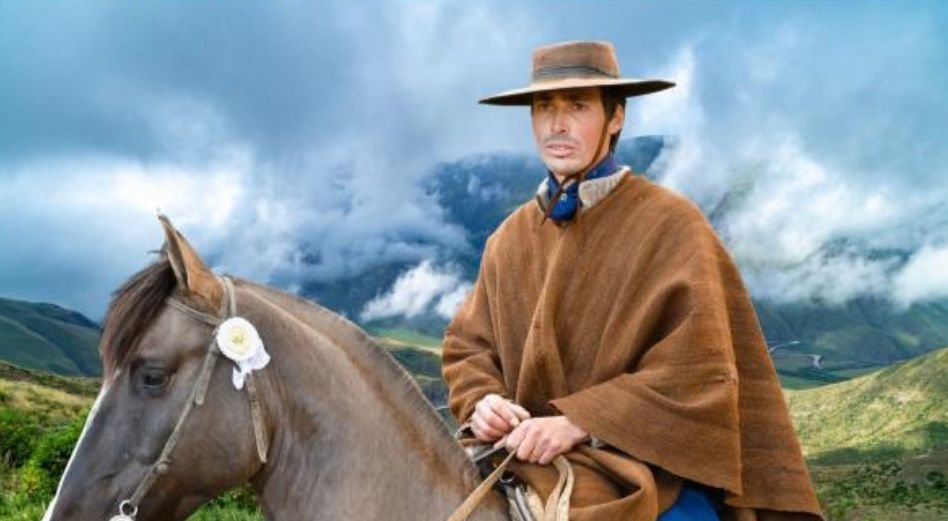Mate, a traditional South American herbal tea, holds great significance in gaucho culture and social gatherings. It is a symbol of friendship, camaraderie, and hospitality among gauchos. The preparation and sharing of mate are integral to gaucho traditions, fostering a sense of community and connection.
Gauchos often gather around a communal mate gourd, passing it around while sharing stories, songs, and laughter. The mate ceremony represents mutual respect, trust, and the bonds forged among gauchos. The sharing of mate is a cherished ritual that reflects the gaucho’s close-knit community and their appreciation for the simple joys of life.
CONCLUSION
Gaucho life is intertwined with a rich tapestry of skills and traditions. From their exceptional horsemanship and riding techniques to their adept use of boleadoras, gauchos showcase remarkable expertise in tasks essential to ranching and survival in the Argentine countryside. Their skills in lassoing, cattle branding, and riding competitions further highlight their prowess and deep connection to their rural way of life. Additionally, the mate culture fosters a sense of community and kinship among gauchos, exemplifying their values of friendship and hospitality. These skills and traditions not only demonstrate the gaucho’s resilience but also preserve the cultural heritage that continues to captivate and inspire us today.
V. DAILY LIFE OF GAUCHOS
Gaucho estancias (ranches) and their organization
Gauchos primarily inhabit and work on gaucho estancias, which are expansive ranches that serve as the center of their daily lives. These estancias are vast in size, consisting of fertile grasslands, cattle herds, and various outbuildings. They provide the necessary infrastructure for gaucho life, including housing, corrals, and facilities for livestock management.
Within the estancias, gauchos have designated areas for communal activities such as dining, socializing, and resting. The organization of the estancias reflects the practicality and functionality required for efficient ranching operations and the communal aspects of gaucho life.
Roles and responsibilities within the gaucho community
Gaucho communities have a hierarchical structure that is based on experience, knowledge, and trust. Within this structure, different roles and responsibilities are assigned to ensure the smooth functioning of the estancia and the collective well-being of the community.
Experienced gauchos, known as “capataces,” hold leadership positions and oversee the day-to-day operations of the estancia. They are responsible for managing tasks such as herding, branding, and maintenance of the livestock. Other gauchos work as vaqueros, specializing in herding and handling the cattle, while some focus on horse training, known as “domadores.”
The gaucho community is interconnected, and cooperation and mutual support are vital. Gauchos often work together on large-scale tasks, such as rounding up and moving cattle, requiring coordination and teamwork.
Gaucho diet and traditional cuisine, including asado (barbecue)
The gaucho diet reflects the demanding nature of their work and the availability of resources on the ranch. Their cuisine revolves around hearty and protein-rich meals. Beef, a staple of the Argentine diet, features prominently in gaucho meals. Gauchos are known for their mastery of the traditional cooking method called asado, which is an open-fire barbecue.
Asado is a cultural institution among gauchos and a centerpiece of social gatherings. It involves grilling various cuts of beef, such as ribs, flank, and sausages, over an open flame. The slow and careful cooking process results in tender, flavorful meat. Gauchos take pride in their asado skills, considering it an art form passed down through generations.
Recreation and entertainment, such as folk music, dancing, and storytelling
While their work is demanding, gauchos also find time for leisure and entertainment. Music, dance, and storytelling hold a significant place in gaucho culture, offering a means of relaxation and communal bonding.
Folk music, often accompanied by traditional instruments like the guitar and accordion, fills the air during gaucho gatherings. Gauchos showcase their musical talents, singing heartfelt songs that celebrate their land, their struggles, and their values. These melodies reflect the deep connection between gauchos and the vast Argentine countryside.
Dance is another integral part of gaucho culture. Traditional folk dances, such as the chacarera and zamba, are performed with grace and vigor, preserving the heritage and spirit of the Argentine countryside.
Storytelling is a cherished pastime among gauchos. Gathered around the warmth of a campfire, they share tales of legendary exploits, historical events, and personal experiences. Through storytelling, gauchos pass down their wisdom, traditions, and values to future generations.
CONCLUSION
The daily life of gauchos revolves around the rhythm of estancia work, communal living, and the preservation of their cultural heritage. Living and working on gaucho estancias, gauchos assume specific roles and responsibilities, ensuring the smooth functioning of the community. Their diet is characterized by hearty meals, with asado being a central culinary tradition that brings gauchos together in shared meals and social gatherings. Beyond work, gauchos engage in recreational activities that celebrate their culture. Folk music fills the air, accompanied by the vibrant rhythms of traditional dances, fostering a sense of unity and celebration. Storytelling around the campfire allows gauchos to preserve their history, pass down wisdom, and nurture the bond between generations.
In the daily life of gauchos, there is a delicate balance between labor and leisure, providing a holistic experience that embodies their rich cultural heritage. The estancia serves as the backdrop for their communal living, where work, sustenance, and entertainment seamlessly merge, creating a sense of purpose, camaraderie, and fulfillment.
As we delve deeper into the world of gauchos, we will explore the intricacies of their skills, traditions, and the unique cultural tapestry they have woven throughout their daily lives. Continue reading to uncover the captivating stories and vibrant traditions that make gaucho life an enduring symbol of Argentine identity and pride.
VI. CHALLENGES AND CHANGES IN MODERN TIMES
Impact of urbanization and industrialization on gaucho communities
Gaucho communities have faced significant challenges in the face of urbanization and industrialization. As cities expanded and industrial activities took hold, the traditional rural way of life underwent profound transformations. Many gauchos were drawn to urban centers in search of better economic opportunities, leaving behind their ancestral lands and communities.
The encroachment of urbanization and industrialization on gaucho territories has led to the fragmentation and loss of vast grasslands. The conversion of land for agriculture and urban development has diminished the available space for traditional gaucho activities. The resulting changes in the landscape have posed significant challenges to the gaucho way of life, their connection to the land, and the preservation of their cultural heritage.
Efforts to preserve gaucho traditions and cultural heritage
Recognizing the importance of preserving gaucho traditions and cultural heritage, various initiatives have emerged to safeguard their way of life. Government organizations, cultural institutions, and grassroots movements have collaborated to raise awareness, document oral histories, and promote the cultural value of gauchos.
Efforts to preserve gaucho traditions include the establishment of museums, cultural centers, and festivals dedicated to showcasing gaucho culture. These venues serve as spaces for exhibitions, performances, and educational programs that celebrate gaucho traditions and share them with a wider audience.
Furthermore, the inclusion of gaucho traditions in UNESCO‘s Intangible Cultural Heritage List has provided international recognition and support for their preservation. These initiatives play a crucial role in raising awareness, fostering pride, and ensuring the continuity of gaucho traditions for future generations.
Modern adaptations and innovations within gaucho culture
Gaucho culture has not remained stagnant in the face of modern challenges. While striving to preserve their traditions, gauchos have embraced modern adaptations and innovations to ensure the sustainability and relevance of their way of life.
Some gauchos have sought new economic opportunities by diversifying their activities. They have explored agrotourism, offering visitors an authentic experience of gaucho life, sharing their traditions, and providing insights into their daily routines. This approach not only supports the preservation of gaucho culture but also contributes to the local economy.
Additionally, gauchos have integrated modern technologies and techniques into their practices. From the use of GPS systems to monitor livestock to the adoption of more sustainable ranching practices, gauchos have shown adaptability and forward-thinking in finding a balance between tradition and innovation.
Contemporary perspectives on gaucho identity and its relevance in Argentine society
In contemporary Argentine society, the gaucho identity continues to hold cultural and symbolic significance. Gauchos are celebrated as cultural icons, representing Argentina’s rural heritage, independence, and resilience. They embody values of tradition, craftsmanship, and a deep connection with the land.
The gaucho identity is not limited to those who are directly engaged in rural activities. It has also permeated various aspects of Argentine society, influencing art, literature, music, and fashion. The gaucho’s allure and mystique continue to captivate the imagination of both Argentines and visitors from around the world.
Contemporary perspectives on gaucho identity recognize its relevance beyond its historical context. The gaucho spirit, characterized by resilience, self-sufficiency, and a love for freedom, resonates with individuals seeking to reconnect with nature, uphold traditional values, and embrace a simpler way of life.
CONCLUSION
In the face of urbanization, industrialization, and changing social dynamics, gaucho communities have confronted challenges to their traditional way of life. However, efforts to preserve gaucho traditions, modern adaptations, and a continued appreciation for gaucho culture have ensured its endurance in Argentine society. The gaucho identity remains a powerful symbol of Argentina’s cultural heritage, capturing the spirit of resilience, independence, and connection to the land.
As we navigate the complexities of the modern world, it is essential to recognize and celebrate the gaucho’s place in Argentine society. By preserving and promoting gaucho traditions, we not only honor the past but also provide a bridge to the future. Through continued efforts to safeguard their cultural heritage, gauchos can inspire future generations to embrace their roots, value tradition, and find harmony between the old and the new.
The gaucho spirit continues to resonate with individuals seeking authenticity, a sense of belonging, and a deeper connection to nature. Whether through agrotourism experiences, cultural events, or artistic expressions, the gaucho identity enriches the cultural tapestry of Argentina and serves as a reminder of the enduring values that transcend time.
In conclusion, as gauchos adapt to the challenges of modern times, their traditions, skills, and cultural significance remain integral to Argentine society. By preserving their heritage, embracing modern innovations, and fostering a contemporary understanding of gaucho identity, we can ensure that the spirit of the gauchos thrives for generations to come. Let us continue to appreciate, learn from, and celebrate the rich legacy of the gauchos and their enduring place in Argentine culture.
VII. CONCLUSION
Recap key points about gaucho life in Argentina
Throughout this exploration of gaucho life in Argentina, we have uncovered key aspects that define the gaucho’s way of living. We started with a brief overview of gauchos and their significance in Argentine culture, understanding their historical importance and cultural symbols. We then delved into gaucho identity and attire, highlighting the defining characteristics of gauchos and the cultural significance of their traditional clothing.
Moving forward, we explored the gaucho skills and traditions that make them unique. From their exceptional horsemanship and use of boleadoras to their mastery of lassoing, cattle branding, and riding competitions, gauchos showcase a range of skills deeply tied to their rural lifestyle. Additionally, we discussed the importance of mate culture in gaucho social gatherings, fostering community and camaraderie.
We then examined the challenges and changes gauchos face in modern times. The impact of urbanization and industrialization, as well as efforts to preserve gaucho traditions and cultural heritage, were explored. We acknowledged the modern adaptations and innovations within gaucho culture and discussed contemporary perspectives on gaucho identity and its relevance in Argentine society.
Reflect on the enduring cultural legacy of gauchos
The legacy of the gauchos extends far beyond the confines of their historical era. Their cultural impact and symbolism remain deeply ingrained in the fabric of Argentine society. Gauchos represent the spirit of independence, resilience, and a profound connection to the land that resonates with people across generations.
Their traditions, skills, and folklore continue to inspire artists, writers, and musicians, infusing Argentine culture with a sense of authenticity and identity. The enduring image of the gaucho as a noble horseman, adorned in traditional attire and surrounded by the vast landscapes of Argentina, serves as a powerful symbol of national pride.
Final thoughts on the importance of preserving and celebrating gaucho traditions in the modern era
In the fast-paced, interconnected world of the modern era, it is essential to recognize and preserve cultural traditions that have shaped our identities. The gaucho way of life, with its rich heritage and timeless values, deserves to be honored and celebrated.
By preserving gaucho traditions, we not only pay homage to the past but also ensure that future generations can appreciate and embrace their cultural roots. The endurance of gaucho traditions provides a link to our history and reminds us of the values of resilience, self-sufficiency, and respect for the land.
In preserving and celebrating gaucho traditions, we cultivate a sense of cultural pride and strengthen the collective identity of Argentina. It is through understanding and embracing the legacy of the gauchos that we can truly appreciate the depth and richness of Argentine culture.
As we conclude this exploration of gaucho life in Argentina, let us remember the gauchos’ enduring legacy and the importance of preserving their traditions. By recognizing their contributions and celebrating their cultural heritage, we ensure that the spirit of the gauchos lives on, inspiring future generations and keeping their vibrant traditions alive in the modern era.


